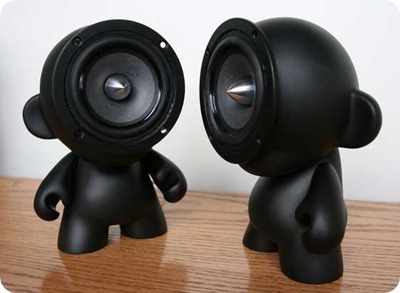How To Shop For Computer Speakers By Frequency Response
 When it comes to desktop computer audio speakers, there are basically three major types. Pods, small towers and small towers with subwoofer.
When it comes to desktop computer audio speakers, there are basically three major types. Pods, small towers and small towers with subwoofer.
Pods are little speakers and are powered by USB and/or battery. Example of pod-type speakers. Pods go by many names. Sometimes “cubes” (with rounded edges), sometimes “eggs”, sometimes “spheres”. Whatever they’re called, a pod is a pod.
Small towers are the most common type of computer speaker, and still the de facto standard on many desktops. Example of small towers.
Small towers with subwoofer are mostly the same as small towers with the addition of a third floor speaker. Example of small towers with subwoofer.
Small towers are typically referred to by the industry as ‘satellites’, particularly in satellite+subwoofer setups.
For many people, it’s all about the bass – but even if you’re not into booming bass and just want to purchase a good standard speaker set without a subwoofer, how can you judge whether speakers are going to have good response or not? Chances are you’re not going to hear the speakers before buying them, so you’ll have to go by the numbers, as in the frequency response numbers.
It’s not all about the watts
A general misconception is that more watts = louder and better. Not really, or at least not with desktop computer speakers. The shape of the speakers matters as does the frequency response. If the speaker boxes cannot accommodate lower tones and/or the frequency response for those speakers in the lower Hz ranges just isn’t there, the only thing more watts will do is distort the sound faster as you increase volume.
This fact is especially true concerning computer speakers without a subwoofer. The two most common watt ratings for computer speaker sets are 2-watt (1 watt RMS/ea.) and 5-watt (2.5 watt RMS/ea.); it is very unlikely you will notice the difference between the two in loudness or clarity – given the speaker box shapes were the same for both sets.
Shape matters
Tall-and-skinny speakers without a subwoofer can carry midrange and high tones fairly well but don’t do much in the bass dept. Why? Because the boxes can’t push that much air.
Many speakers-with-subwoofer sets have the satellites as tall-and-skinny because the subwoofer takes care of the lower Hz frequencies the satellites can’t reproduce.
Put in simpler terms: If you’re not interested in a subwoofer but want something that can throw a little air and get some decent bass response, short/squat rectangles (but not cubes) are better than tall/skinny ones.
Understanding frequency response
It is generally believed that the human hearing range is from 20Hz (low bass tones) to 20kHz (20,000Hz, high treble tones).
The first thing to know up front about speaker sets without subwoofers is to never expect a starting range of 20Hz, because those smaller boxes simply can’t do it.
It is reasonable however to expect the low Hz range to start at about 100Hz and at best (less is better here) 50Hz – however it should be noted that even some expensive speakers start at around 85Hz because it better accommodates to some speaker box designs.
Believe me when I say that desktop speakers that can reproduce 50Hz at the start of the frequency range can truly thump; it’s pretty much the ‘bassiest’ you can get before adding in a subwoofer.
On the other (“high”) side of the frequency range, 20kHz/20,000Hz is more or less universally standard even for the cheapest of desktop speakers. For this side a lower frequency is worse, so if shopping for speakers and see the range end at less than 20kHz, I’d give it a miss.
One instance where a low cutoff on the high end of the frequency is OK are for outdoor speakers like this set or this set. Those particular models have a ‘ceiling’ of 15kHz – but that’s acceptable given their intended application.
When sitting directly in front of the speakers on a computer desktop however, you want a set that can reproduce the higher 20kHz end of the range.
“If I can’t hear anything over 17kHz, why would I want a speaker set that can reproduce 20kHz?”
Most people over the age of 24 cannot hear tones over 17.4kHz, commonly known as the “Mosquito Tone” (more info here with examples if you scroll down that page), however when it comes to audio speakers, you’re not trying to hear any one specific tone but a fuller range of them.
With computer monitors for example, they can reproduce more colors than the human eye is capable of actually seeing, however the more colors it can reproduce, the more true-to-life the images appear. The same can be said for audio speakers with its frequency ranges. The more tones it can produce, the more realistic the sound is. Even though you may not be able to hear anything over 17kHz, you want the speaker to be able to reproduce it regardless to get the fullest, richest sound. (Yes, this is my interpretation and is open for debate. If anyone has a better way of describing why the 20kHz ceiling matters, be my guest and post a comment or two with your thoughts.)
[Image from Instructables “Munny Speakers” article]





















4 thoughts on “How To Shop For Computer Speakers By Frequency Response”
One has a high frequency response of 22,000 the other has 20,000.
Will I hear a difference.
Of cocurse, we all want the lows to appreciate music. In days (long gone by) I had a huge speaker cabinet with a 15 inch woofer to bring me clear and crisp bass as in the huge string bass. The much smaller speakers of today do a pretty good job for my ears. Even the best of speakers are lousy, however, if the system doesn’t produce a more faithful reproduction of the real thing. Remember sound starts with an analog signal, An adequate smapling rate is necesssary to yield an adequate or even close resemblance to the original analog signal. May I offer to you younger ones a suggestion that you protect your hearing? It is one of those things that makes your day in old age. Trust me.
http://oyun.xp3.biz/